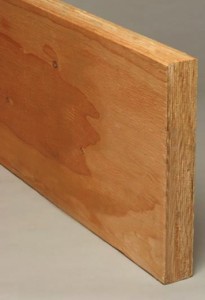
Hi Everyone
My last newsletter was on the business side of remodeling as it related to the state of our economy. This time, I would like to get back to some of the nuts and bolts issues of remodeling.
If you were to ask me…Stan-what has been the greatest technological advancement you have seen in your thirty years in the remodeling industry? My answer would be simple and to the point, “LVL”. What the heck is LVL? LVL stands for laminated veneer lumber. What is laminated veneer lumber? Well…let me explain.
In the past, we contractors and architects used to only have two alternatives when structurally designing for a remodel job. Our choices were either steel beams or dimensional lumber (meaning 2X solid wood). Both of these alternatives are still very much being used today. The problem was that if you wanted to keep prices down you would choose wood, but wood had a significant drawback. It was very difficult to use to span large distances (say over 10 feet) without getting a very sizable beam or even worse you would need to sandwich multiple beams together to achieve the strength you needed the beam to carry. Also you didn’t want the beam to be too bouncy (deflection).
In the late 1970’s the technology was developed to create a cheaper alternative to 4X8 plywood panels. OSB (oriented strand board) became an overnight success with architects and builders alike. The original technology had some problems, but by the 1980’s the problems were solved and OSB became the sheathing of choice for most remodelers.
So along in the 1980’s comes the invention of LVL beams. Laminated veneer lumber is an engineered wood product that uses multiple layers of thin wood assembled with adhesives. So even though it still is actual wood, it is put together in a factory using small pieces of wood and glue. Now, surprisingly enough, there are numerous benefits. First and foremost it is significantly stronger. A LVL has about 4 times the strength of a normal lumber. This means you can use less wood to achieve the same thing. Second it is straighter. The normal lumber is cut from a tree. It is then kiln dried to remove a certain amount of moisture. This drying process shrinks the lumber and in many cases warps and twists it as well. And thirdly it is more uniform. An LVL is “assembled” and has far less shrinkage and warpage so it remains dimensionally stable. Whether you are installing it in high or low humidity conditions, the LVL remains dimensionally stable because it has been made in a factory under controlled specifications. That is a huge plus for contractors. LVL’s have many other usages than beams. They can be used above windows as a lintel, above an opening as a header, as floor joists, or ceiling rafters, and many additional uses.
A common name for LVL is Microllam. This is just one manufacturer’s trademark name. Something like Kleenex tissues… were Kleenex is just one manufacturer’s brand name that has become synonymous with tissues.
So I pick LVL as my most important technological advancement in my 30 years in the remodeling business.
I want to wish everyone a Happy Thanksgiving and I also want to convey Seasons Greetings to all of you who have supported me and my company. My sincere hope is that the new year brings peace, happiness, and prosperity to each and every one of you.


